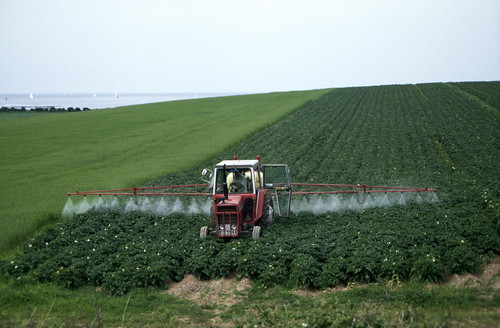 |
| Photo of crop spraying by tpmartins on Flickr |
Roundup herbicide, used extensively on GM crops, has long been hyped as environmentally friendly: it is claimed not to linger in the ecosystem and to have low toxicity for animals. The bigger picture, however, seems to be much more complex, and much more damaging than previously assumed.
Parasites can be a major problem in intensive farming, especially if the offending organism can move away to multiply in the natural surrounding before coming back to re-infest the livestock.
One such parasite is the trematode worm, Telogaster opisthorchis, which spends its adult life in freshwater fish and its larval, 'cercarial', form in snails which share the same environment. Infestation doesn't kill the fish, but causes spinal malformations in the young. Experimental evidence supports the industry hype that glyphosate, at environmentally relevant concentrations, doesn't kill either the fish or the snails.
However, an experiment on the more complex reality of glyphosate/fish/snail/parasite interactions gave some ominous results:
- When the fish were exposed to both the parasite and a low, environmentally relevant, concentration of glyphosate, their survival was significantly reduced.
- When snails were exposed simultaneously to the parasite and varying levels of the herbicide, a glyphosate-dependent effect was evident. Low concentrations of glyphosate (as in the fish experiment) produced no change from normal. But when the concentration of glyphosate was increased to the maximum recommended application rates, the snails supported a significantly greater number of parasite cercariae (ready to re-infect the fish).
Farmed animals, from fish to cattle, pigs, chickens and bees, are exposed to glyphosate in the air around them, in the water they drink and bath in, and in their food.
The authors of this study concluded:
“... glyphosate might increase the risk of disease in fish. Our results have important implications when identifying risks to aquatic communities and suggest that threshold levels of glyphosate currently set by regulatory authorities do not adequately protect freshwater systems.”
OUR COMMENT
In the GM SALMON SAGA (February 2012), we noted that:
“In 2009, GM fish from the research facilities on Prince Edward Island, Canada, tested positive for a mutated version of Salmon Anaemia virus. Any such infection prevents permits being issued either for import or domestic transfers. COMMENT It's never been revealed whether the fast-growing fish are susceptible to viral or other infections, nor whether the viral mutation was facilitated by the GM fish. This could be a major human and environmental health issue, a major animal welfare issue, and a major commercial issue.”
All inland farmed fish, including GM salmon, may be fed on GM, glyphosate-doused, soya and there may be glyphosate run off into their pens. Was there some glyphosate/GM-feed/GM-fish/virus synergy going on in the Prince Edward Island farms?
Such complex interactions are possible (some would say probable) and must be clarified before whole sectors of our farming and food supplies collapse.
Up until now, the biotech industry has got away with simplistic, reductionist science which can easily prove the toxins linked to GM crops are 'safe' because in isolation they do not kill healthy test animals. Harmful consequences from chronic exposure to glyphosate and its promotion of infectious disease will be continue to be ignored until YOU demand appropriate testing and monitoring.
SOURCES
- David W. Kelly, et al, 2010, Synergistic effects of glyphosate formulation and parasite infection on fish malformations and survival, Journal of Applied Ecology, 47
- Robert McClure, New study shows Roundup pesticide kills fish, Investigate West, 3.02.10
No comments:
Post a Comment
Thanks for your comment. All comments are moderated before they are published.